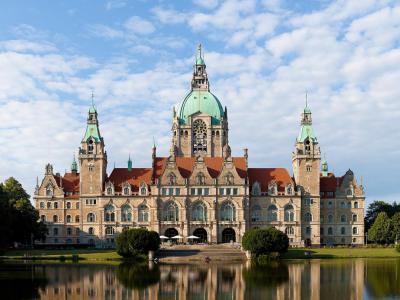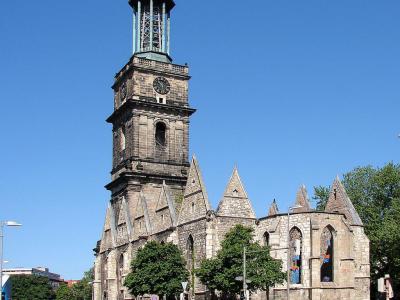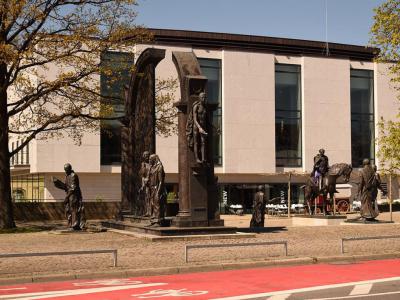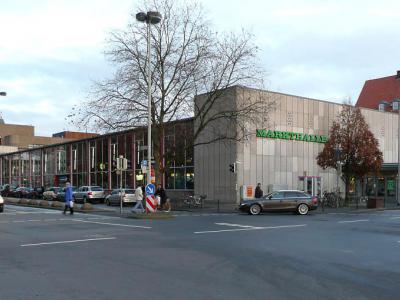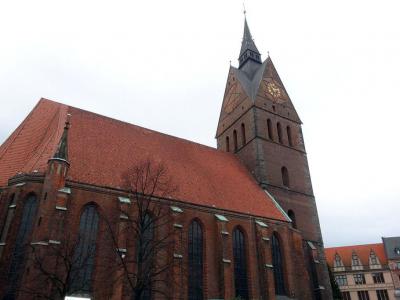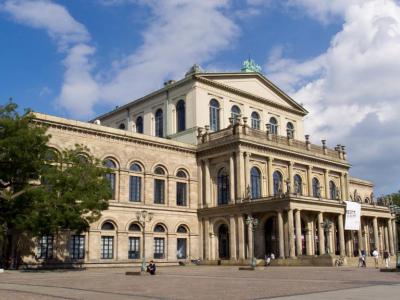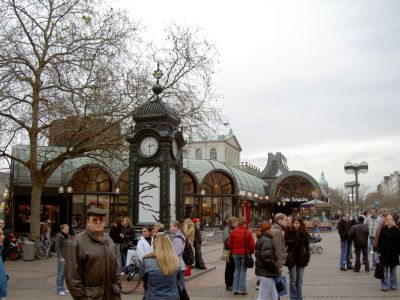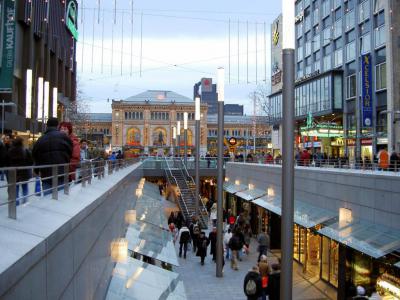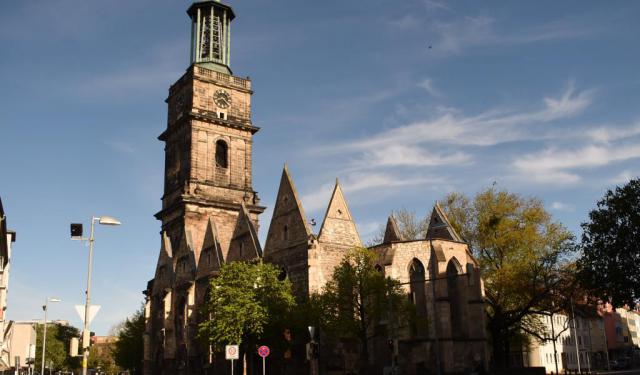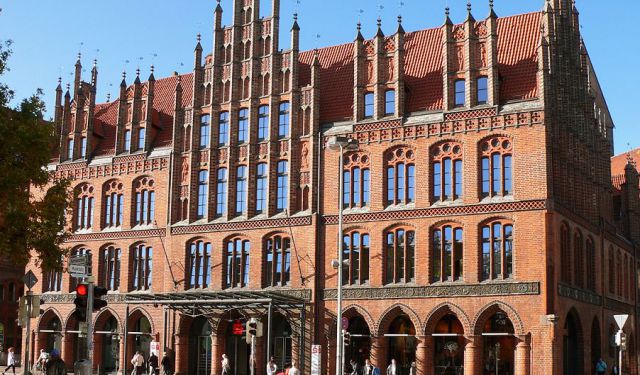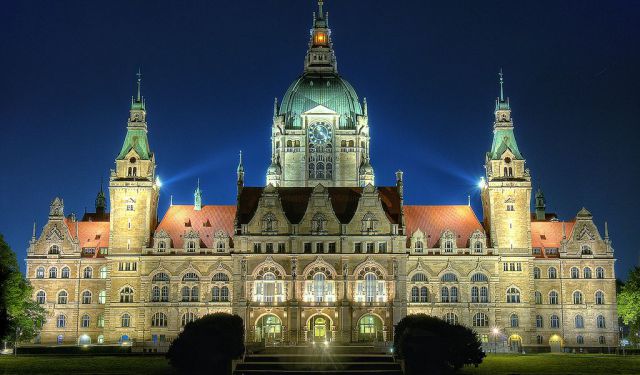
Hanover Introduction Walking Tour (Self Guided), Hanover
Hanover began in medieval times as a small village of fishermen on the banks of the River Leine. By the 13th century, it was a large town by the day's standards. The name, initially "Honovere," likely meant "high river bank".
The town's location is a natural crossroads in the region, with the river providing navigable routes and its location on the North German Plain, making it a stop for mule trains. By the 14th century, the city had walls, churches, and even greater trade.
George, Duke of Brunswick-Lüneburg, moved his residence to Hanover in 1638. In 1692, the Holy Roman Emperor elevated the Duke to the rank of Prince-Elector. Thus began the so-called House of Hanover. These Electors later became the monarchs of Great Britain and Ireland. The first was George I Louis, who acceded to the British throne in 1714.
Despite these close connections, the British monarchs seldom visited the city. In 1837, when Queen Victoria took the British crown, women were not allowed to inherit Hanover, and so it passed to Victoria's uncle, Ernest Augustus. Then, in 1866, the kingdom was annexed by Prussia. It was a time of political upheaval that eventually helped form the foundations for a liberal republic in Germany. You can learn more about the steps to getting there at the Göttingen Seven Monument.
Much of the city was devastated by bombing during World War II. Nowhere will this history be more evident than a trip to Aegidia Church (Aegidienkirche). The church was left in ruins by bombs and not rebuilt. To this day, it stands as a memorial to that war.
Today, Hanover is a bustling metropolitan city brimming with culture and history. Some of the oldest buildings are Old Town Hall and Market Church. Don't miss the views from atop the dome at New City Hall, strolling for snacks and coffee at Market Hall. Try to catch a show at the Opera House for a touch of culture.
Hanover is a beautiful city with lots to see and do. So grab your walking shoes and smart phone--let's take a walk in Hanover.
The town's location is a natural crossroads in the region, with the river providing navigable routes and its location on the North German Plain, making it a stop for mule trains. By the 14th century, the city had walls, churches, and even greater trade.
George, Duke of Brunswick-Lüneburg, moved his residence to Hanover in 1638. In 1692, the Holy Roman Emperor elevated the Duke to the rank of Prince-Elector. Thus began the so-called House of Hanover. These Electors later became the monarchs of Great Britain and Ireland. The first was George I Louis, who acceded to the British throne in 1714.
Despite these close connections, the British monarchs seldom visited the city. In 1837, when Queen Victoria took the British crown, women were not allowed to inherit Hanover, and so it passed to Victoria's uncle, Ernest Augustus. Then, in 1866, the kingdom was annexed by Prussia. It was a time of political upheaval that eventually helped form the foundations for a liberal republic in Germany. You can learn more about the steps to getting there at the Göttingen Seven Monument.
Much of the city was devastated by bombing during World War II. Nowhere will this history be more evident than a trip to Aegidia Church (Aegidienkirche). The church was left in ruins by bombs and not rebuilt. To this day, it stands as a memorial to that war.
Today, Hanover is a bustling metropolitan city brimming with culture and history. Some of the oldest buildings are Old Town Hall and Market Church. Don't miss the views from atop the dome at New City Hall, strolling for snacks and coffee at Market Hall. Try to catch a show at the Opera House for a touch of culture.
Hanover is a beautiful city with lots to see and do. So grab your walking shoes and smart phone--let's take a walk in Hanover.
How it works: Download the app "GPSmyCity: Walks in 1K+ Cities" from Apple App Store or Google Play Store to your mobile phone or tablet. The app turns your mobile device into a personal tour guide and its built-in GPS navigation functions guide you from one tour stop to next. The app works offline, so no data plan is needed when traveling abroad.
Hanover Introduction Walking Tour Map
Guide Name: Hanover Introduction Walking Tour
Guide Location: Germany » Hanover (See other walking tours in Hanover)
Guide Type: Self-guided Walking Tour (Sightseeing)
# of Attractions: 9
Tour Duration: 2 Hour(s)
Travel Distance: 2.3 Km or 1.4 Miles
Author: Caroline
Sight(s) Featured in This Guide:
Guide Location: Germany » Hanover (See other walking tours in Hanover)
Guide Type: Self-guided Walking Tour (Sightseeing)
# of Attractions: 9
Tour Duration: 2 Hour(s)
Travel Distance: 2.3 Km or 1.4 Miles
Author: Caroline
Sight(s) Featured in This Guide:
- Neues Rathaus (New City Hall)
- Aegidienkirche (Aegidia Church)
- Denkmal der Göttinger Sieben (Göttingen Seven Monument)
- Markthalle (Market Hall)
- Marktkirche (Market Church)
- Altes Rathaus (Old Town Hall)
- Staatsoper Hannover (Opera House)
- Kropcke Platz (Kropcke Square)
- Bahnhofstrasse (Train Station Street)
1) Neues Rathaus (New City Hall) (must see)
The New City Hall, which was inaugurated in 1913 and dedicated by Emperor Wilhelm II, is an impressive architectural masterpiece. During its construction, the city director proudly informed the Emperor that the entire building had been funded with cash, amounting to over ten million marks.
This remarkable edifice resembles a castle and boasts an eclectic architectural style. Situated alongside the Leine River, New City Hall presents a breathtaking sight at night when its lights cast shimmering reflections in the water.
The centerpiece of New City Hall is its towering dome, reaching a height of 97.73 meters (320.6 feet) and offering panoramic views of the Harz mountain range from its observation platform. The dome is equipped with a unique elevator that ascends at a 17-degree angle, covering a distance of 50 meters (160 feet). Originally in operation from 1913 to 2007, this lift was eventually replaced with a new one.
Unfortunately, New City Hall suffered damage during World War II when American forces bombed the city. In 1946, the proclamation of the German state of Niedersachsen was made from within its walls.
Presently, New City Hall serves as the administrative hub for the Lord Mayor's offices and hosts various political committee meetings, as well as official receptions for guests. Additionally, the building hosts a range of exhibitions throughout the year.
Visitors to New City Hall can explore four Hannover city models on the ground floor, each depicting the city's evolution over different historical periods, including the Middle Ages, pre-World War II, post-World War II, and the contemporary era. Furthermore, guests are invited to savor a refined dining experience at the Garden Hall bistro.
Tip:
Pay a few euros and take the elevator to the dome. With its glass floor, the view up and down is brilliant! Once you emerge from the shaft you have to take several spiral staircases to the very top of the dome. Be prepared to be blown away by the wind and by the incredible views of Hannover itself. Finally, you can have a casual lunch or tea in the beautifully appointed restaurant.
This remarkable edifice resembles a castle and boasts an eclectic architectural style. Situated alongside the Leine River, New City Hall presents a breathtaking sight at night when its lights cast shimmering reflections in the water.
The centerpiece of New City Hall is its towering dome, reaching a height of 97.73 meters (320.6 feet) and offering panoramic views of the Harz mountain range from its observation platform. The dome is equipped with a unique elevator that ascends at a 17-degree angle, covering a distance of 50 meters (160 feet). Originally in operation from 1913 to 2007, this lift was eventually replaced with a new one.
Unfortunately, New City Hall suffered damage during World War II when American forces bombed the city. In 1946, the proclamation of the German state of Niedersachsen was made from within its walls.
Presently, New City Hall serves as the administrative hub for the Lord Mayor's offices and hosts various political committee meetings, as well as official receptions for guests. Additionally, the building hosts a range of exhibitions throughout the year.
Visitors to New City Hall can explore four Hannover city models on the ground floor, each depicting the city's evolution over different historical periods, including the Middle Ages, pre-World War II, post-World War II, and the contemporary era. Furthermore, guests are invited to savor a refined dining experience at the Garden Hall bistro.
Tip:
Pay a few euros and take the elevator to the dome. With its glass floor, the view up and down is brilliant! Once you emerge from the shaft you have to take several spiral staircases to the very top of the dome. Be prepared to be blown away by the wind and by the incredible views of Hannover itself. Finally, you can have a casual lunch or tea in the beautifully appointed restaurant.
2) Aegidienkirche (Aegidia Church) (must see)
The Gothic-style Aegidien Church was built in 1347. It sits on the location of a 12th-century Romanesque church. Hanover's 16th century Reformation began in Aegidiean Church. In the early 1700s, a Baroque facade was added to the church's steeple. In 1826, Georg Ludwig Friedrich Laves remodeled the church's interior.
In 1943, the church was destroyed by World War II bombs. The church was left in ruins with only its outer walls intact. The church was not rebuilt after the war, rather it today functions as a war memorial. In 1959, Kurt Lehmann designed and installed a monumental sculpture called Humility.
The outer walls feature many Baroque epitaphs, including one dedicated to Susanna Magdalena Oldekop, who died as a child in 1648.
A relief known as the Siebenmannenstein shows seven praying men who allegedly sacrificed themselves to save the town. The men are known as "Hannover's Spartans," who died during an attack on Dohren Tower in 1480. The Siebenmannenstein relief is a copy. The original can be seen in the Hannover Historical Museum.
The contemplative Schattenlinie artwork features a white stone line that capture's the church's shadow. This artwork is a symbol of life and death, and of light and shadows.
Hiroshima, Japan, is Hanover's sister city. Hiroshima donated a peace bell to Hanover, and it is now located in the Aegidien Church's tower. It is rung every year on Hiroshima Day which is August 6th.
In 1943, the church was destroyed by World War II bombs. The church was left in ruins with only its outer walls intact. The church was not rebuilt after the war, rather it today functions as a war memorial. In 1959, Kurt Lehmann designed and installed a monumental sculpture called Humility.
The outer walls feature many Baroque epitaphs, including one dedicated to Susanna Magdalena Oldekop, who died as a child in 1648.
A relief known as the Siebenmannenstein shows seven praying men who allegedly sacrificed themselves to save the town. The men are known as "Hannover's Spartans," who died during an attack on Dohren Tower in 1480. The Siebenmannenstein relief is a copy. The original can be seen in the Hannover Historical Museum.
The contemplative Schattenlinie artwork features a white stone line that capture's the church's shadow. This artwork is a symbol of life and death, and of light and shadows.
Hiroshima, Japan, is Hanover's sister city. Hiroshima donated a peace bell to Hanover, and it is now located in the Aegidien Church's tower. It is rung every year on Hiroshima Day which is August 6th.
3) Denkmal der Göttinger Sieben (Göttingen Seven Monument)
The Göttingen Seven were liberal professors from Göttingen. In 1837, these professors protested against King Ernest Augustus. The new king wanted to alter Hannover's constitution, and the Göttingen Seven refused to swear an oath to the new king.
The Göttingen Seven included historian Friedrich Christoph Dahlmann, jurist Wilhem Eduard Albrecht, historian Georg Gottfried Gervinus, theolgian Heinrich Georg August Ewald, and physicist Wilhelm Eduard Weber. In addition, the group included Wilhelm and Jacob Grimm, the popular fairy tale writers known as the Brothers Grimm.
Friedrich Christoph Dahlmann led the protest against the King's annulment of the constitution. The six other professors signed their opposition, and the group became known as the Göttingen Seven. Following their protest, the seven professors were questioned by the university court. As a result, they were all relieved of their teaching posts. Dahlmann, Jacob Grimm, and Gervinus were given three days to leave the country.
The professors were popular, and this controversial story inspired the public and media. The Göttingen Seven sparked a movement that led to Germany creating a liberal republic.
The bronze monument features the Göttingen Seven in different locations. The three exiled professors are placed outside an ajar gate. The four professors who were dismissed but not exiled are shown inside the gate.
The Göttingen Seven included historian Friedrich Christoph Dahlmann, jurist Wilhem Eduard Albrecht, historian Georg Gottfried Gervinus, theolgian Heinrich Georg August Ewald, and physicist Wilhelm Eduard Weber. In addition, the group included Wilhelm and Jacob Grimm, the popular fairy tale writers known as the Brothers Grimm.
Friedrich Christoph Dahlmann led the protest against the King's annulment of the constitution. The six other professors signed their opposition, and the group became known as the Göttingen Seven. Following their protest, the seven professors were questioned by the university court. As a result, they were all relieved of their teaching posts. Dahlmann, Jacob Grimm, and Gervinus were given three days to leave the country.
The professors were popular, and this controversial story inspired the public and media. The Göttingen Seven sparked a movement that led to Germany creating a liberal republic.
The bronze monument features the Göttingen Seven in different locations. The three exiled professors are placed outside an ajar gate. The four professors who were dismissed but not exiled are shown inside the gate.
4) Markthalle (Market Hall)
The current Market Hall was built in 1954. The original building was built in 1892 but was destroyed during World War II.
Historically, farmers brought their goods into Hanover and sold them in public marketplaces. However, by the end of the 19th century, the city was concerned about hygiene in the open markets.
In addition, city traffic flow was blocked by market handcarts. As a result, the city built an indoor market hall in 1892. This hall accommodated 243 sellers.
The new Market Hall was built on the old hall's foundation. The current hall has 73 stalls offering a variety of wine, fish, sausage, meat, vegetables, and fruit. Vendors also offer hot food and international specialties. You can shop for groceries or enjoy a cafe meal.
Market Hall is a popular place for residents to meet and enjoy a coffee or glass of wine together. It's locally known as the "belly of Hannover."
Visitors will find a memorial statue dedicated to Karoline Duhnsen at Market Hall's main entrance. Duhnsen is considered the market's original vendor, and she traveled to the market every day for 50 years to sell meat and sausage. Duhnsen died in 2001.
Historically, farmers brought their goods into Hanover and sold them in public marketplaces. However, by the end of the 19th century, the city was concerned about hygiene in the open markets.
In addition, city traffic flow was blocked by market handcarts. As a result, the city built an indoor market hall in 1892. This hall accommodated 243 sellers.
The new Market Hall was built on the old hall's foundation. The current hall has 73 stalls offering a variety of wine, fish, sausage, meat, vegetables, and fruit. Vendors also offer hot food and international specialties. You can shop for groceries or enjoy a cafe meal.
Market Hall is a popular place for residents to meet and enjoy a coffee or glass of wine together. It's locally known as the "belly of Hannover."
Visitors will find a memorial statue dedicated to Karoline Duhnsen at Market Hall's main entrance. Duhnsen is considered the market's original vendor, and she traveled to the market every day for 50 years to sell meat and sausage. Duhnsen died in 2001.
5) Marktkirche (Market Church)
Market Church was initially built in the 14th century. It was built in the North German brick gothic style and is Germany's southernmost example of this unique architectural style.
The church's tall western tower symbolized Hannover's wealth and power. The tower is one of Hannover's most recognizable landmarks. The tower has 11 bells. The Bell of Christ and Peace is Lower Saxony's largest bell and reserved for special occasions.
The church's interior features a carved wooden altar that dates to the late 15th century. The altar's front depicts the Passion of Christ. The altar's back shows scenes from the lives of Saint George and Saint James, the church's patron saints.
The church's roof and naves were damaged by World War II bombs in 1943 and were rebuilt in 1952.
The church's organ was built in 1954 and has 64 stops.
A giant pentagram on the church's western tower is one of its most dramatic elements. In addition, a hexagram surrounds the tower's clock. These symbols were used by ancient pagans and then adopted by early Christians. The pentagram was used to symbolize the epiphany.
Why You Should Visit:
Very impressive church with an imposing presence; easy to find and prettily placed in a lively space in town.
The interior is clean, the design is simple yet fascinating, and the organ is really beautiful.
Tip:
Try to be there when the organ plays – it's fantastic.
The church's tall western tower symbolized Hannover's wealth and power. The tower is one of Hannover's most recognizable landmarks. The tower has 11 bells. The Bell of Christ and Peace is Lower Saxony's largest bell and reserved for special occasions.
The church's interior features a carved wooden altar that dates to the late 15th century. The altar's front depicts the Passion of Christ. The altar's back shows scenes from the lives of Saint George and Saint James, the church's patron saints.
The church's roof and naves were damaged by World War II bombs in 1943 and were rebuilt in 1952.
The church's organ was built in 1954 and has 64 stops.
A giant pentagram on the church's western tower is one of its most dramatic elements. In addition, a hexagram surrounds the tower's clock. These symbols were used by ancient pagans and then adopted by early Christians. The pentagram was used to symbolize the epiphany.
Why You Should Visit:
Very impressive church with an imposing presence; easy to find and prettily placed in a lively space in town.
The interior is clean, the design is simple yet fascinating, and the organ is really beautiful.
Tip:
Try to be there when the organ plays – it's fantastic.
6) Altes Rathaus (Old Town Hall) (must see)
The Old Town Hall was built in 1410 and is Hannover's oldest secular building. Old Town Hall features an impressive red-brick Gothic facade.
The Koebelinger Street wing is known as the Chemist's Wingand housed the town's pharmacy. Architect Conrad Wilhelm Hase rebuilt this wing in Italian Romanesque style in the 1800s.
Hase also renovated the other wings to reflect their original 16th-century style with stunning gothic gables and decorative panels.
Visitors will find a variety of royal portraits and coats of arms on the walls. In addition, visitors can see a picture showing the "Luderziehen," a game played in the Middle Ages. Instead of using a rope, participants would play tug of war with their little fingers.
The town hall was damaged during World War II and restored in 1953 and 1964. Today, visitors can tour the building and enjoy the modern restaurant on the first floor.
The Koebelinger Street wing is known as the Chemist's Wingand housed the town's pharmacy. Architect Conrad Wilhelm Hase rebuilt this wing in Italian Romanesque style in the 1800s.
Hase also renovated the other wings to reflect their original 16th-century style with stunning gothic gables and decorative panels.
Visitors will find a variety of royal portraits and coats of arms on the walls. In addition, visitors can see a picture showing the "Luderziehen," a game played in the Middle Ages. Instead of using a rope, participants would play tug of war with their little fingers.
The town hall was damaged during World War II and restored in 1953 and 1964. Today, visitors can tour the building and enjoy the modern restaurant on the first floor.
7) Staatsoper Hannover (Opera House)
The Opera House was built to replace the Royal Court Theater between 1845 and 1852. It is located on the eastern edge of the old town, near a bastion in the city walls. The building is in the late classicist style and was built by Georg Ludwig Friedrich Laves.
The first performance in the house was of Mozart's Wedding of Figaro. The new opera building replaced the castle theater in Leineschloss. When it first opened, both operas and drama productions were hosted here.
The original opera house burned to the ground after being hit by bombs during World War II. A replica of the original reopened in 1950, with interiors done in the post-war modernism style. It has been modernized several times since, with a significant upgrade occurring in 1985.
Opera House operates as the State Opera, Theater, and Ballet. It currently seats about 1,200. Drama productions, operas, and ballets are held constantly, so check the schedule and try to take in a performance during your stay in Hannover.
The first performance in the house was of Mozart's Wedding of Figaro. The new opera building replaced the castle theater in Leineschloss. When it first opened, both operas and drama productions were hosted here.
The original opera house burned to the ground after being hit by bombs during World War II. A replica of the original reopened in 1950, with interiors done in the post-war modernism style. It has been modernized several times since, with a significant upgrade occurring in 1985.
Opera House operates as the State Opera, Theater, and Ballet. It currently seats about 1,200. Drama productions, operas, and ballets are held constantly, so check the schedule and try to take in a performance during your stay in Hannover.
8) Kropcke Platz (Kropcke Square)
Kropcke Square can't be missed-- mostly because it's such a significant crossroads in modern Hannover. You can't miss it because it is unavoidable that you will pass through here at some point during your stay! It's geographically at the city center, and the locals use it as a meeting place. Below the surface lies the largest hub of Hannover's light rail system.
The intersection has existed since 1843 when it was part of a greater city planning scheme of expanding the metropolitan area. Kropcke Square was to replace the market square near the same location. The first trams were horse-drawn in the 1870s, but they were electrified in the 1930s.
The entire area was heavily bombed during World War II. The only surviving structure was the famous Kropcke clock. The clock was originally a weather column erected in 1885. While it survived the war, it was severely damaged and was replaced ten years later. In 1977, a simplified version of the original weather column was installed.
The area has been pedestrian only since the 1970s.
The intersection takes its name from a renowned cafe that operated here. The Cafe Kropcke was an ornate cast-iron building modeled to look like a Parisian cafe. It opened as the Cafe Robby in 1867, but waiter Wilhelm Kropcke took over in 1895. The cafe had a reputation beyond the limits of Hannover, and eventually, the entire square came to be known by the name of the cafe. The square was officially renamed in 1948.
The intersection has existed since 1843 when it was part of a greater city planning scheme of expanding the metropolitan area. Kropcke Square was to replace the market square near the same location. The first trams were horse-drawn in the 1870s, but they were electrified in the 1930s.
The entire area was heavily bombed during World War II. The only surviving structure was the famous Kropcke clock. The clock was originally a weather column erected in 1885. While it survived the war, it was severely damaged and was replaced ten years later. In 1977, a simplified version of the original weather column was installed.
The area has been pedestrian only since the 1970s.
The intersection takes its name from a renowned cafe that operated here. The Cafe Kropcke was an ornate cast-iron building modeled to look like a Parisian cafe. It opened as the Cafe Robby in 1867, but waiter Wilhelm Kropcke took over in 1895. The cafe had a reputation beyond the limits of Hannover, and eventually, the entire square came to be known by the name of the cafe. The square was officially renamed in 1948.
9) Bahnhofstrasse (Train Station Street)
Train Station Street--or Bahnhofstrasse, as the locals say--is Hanover's main shopping street. It runs from Kropcke Platz, the central square, to the main train station. Until 1968, Train Station Street was a regular road with car traffic and city trams. But today, the street has been pedestrianized.
The main roadway was built in 1843 to connect Ernst August City with the train station. It was surrounded by commercial buildings, but most of those were destroyed during World War II. As a result, most of the buildings you see today have been built in the post-war era of the 20th century. Today you'll find typical chain stores.
Below street level is the Niki-de-Saint-Phalle Promenade. The Promenade may sit below the street, but it is open at the top to feel more like a lower level than a tunnel. It was built in the 1970s as part of a project to expand the city's underground rail infrastructure. Four lines of light commuter rail run under the Promenade level.
The Promenade is named in honor of Niki de Saint Phalle, a Franco-Swiss modern painter and sculptor. She created the famous "Nana" figures in Hannover that you can find on Sculpture Mile (Skulpturenmeile). Additionally, the Sprengel Museum houses over 400 of her works.
The main roadway was built in 1843 to connect Ernst August City with the train station. It was surrounded by commercial buildings, but most of those were destroyed during World War II. As a result, most of the buildings you see today have been built in the post-war era of the 20th century. Today you'll find typical chain stores.
Below street level is the Niki-de-Saint-Phalle Promenade. The Promenade may sit below the street, but it is open at the top to feel more like a lower level than a tunnel. It was built in the 1970s as part of a project to expand the city's underground rail infrastructure. Four lines of light commuter rail run under the Promenade level.
The Promenade is named in honor of Niki de Saint Phalle, a Franco-Swiss modern painter and sculptor. She created the famous "Nana" figures in Hannover that you can find on Sculpture Mile (Skulpturenmeile). Additionally, the Sprengel Museum houses over 400 of her works.
Walking Tours in Hanover, Germany
Create Your Own Walk in Hanover
Creating your own self-guided walk in Hanover is easy and fun. Choose the city attractions that you want to see and a walk route map will be created just for you. You can even set your hotel as the start point of the walk.
Hannover's Historical Churches Walking Tour
Hannover, Germany, boasts a great deal of history that is beautifully reflected in its ancient churches. A good number of them were built as far back as the 14th century. Despite the passage of time, today these architectural marvels remain largely intact, standing as a testament to Hannover's cultural and religious heritage.
One such is the Aegidia Church (Aegidienkirche). Originally... view more
Tour Duration: 1 Hour(s)
Travel Distance: 1.6 Km or 1 Miles
One such is the Aegidia Church (Aegidienkirche). Originally... view more
Tour Duration: 1 Hour(s)
Travel Distance: 1.6 Km or 1 Miles
Architectural Jewels
Even though some may find Hannover rather new looking, the city in fact has a long and eventful history. As a crucial transportation hub, Hannover couldn’t escape Allied bombing during World War II; what used to be a grand city was turned into the rubble – with 90% of the local buildings destroyed. Yet, despite the bombing and ensued reconstruction, many pre-war architectural gems have... view more
Tour Duration: 1 Hour(s)
Travel Distance: 1.5 Km or 0.9 Miles
Tour Duration: 1 Hour(s)
Travel Distance: 1.5 Km or 0.9 Miles
Shopping Areas in Hannover
Hannover is ideally suited for shopping – replete with wonderful markets and elegant boutiques fit to satisfy most shoppers. All the world's top brands are packed here within easily accessible areas. Only a few cities in Germany can offer such a high density of shopping opportunities within just a few hundred meters of each other.
Subject to your interest, you can find here what you need... view more
Tour Duration: 1 Hour(s)
Travel Distance: 1.9 Km or 1.2 Miles
Subject to your interest, you can find here what you need... view more
Tour Duration: 1 Hour(s)
Travel Distance: 1.9 Km or 1.2 Miles
The Most Popular Cities
/ view all
